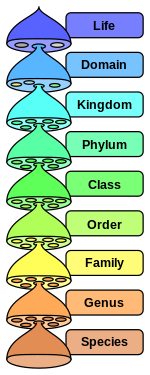Taxonomic rank
Their close relatives are all in the family Canidae, which includes dogs, wolves, jackals, and all foxes; the next higher major taxon, Carnivora (considered an order), includes caniforms (bears, seals, weasels, skunks, raccoons and all those mentioned above), and feliforms (cats, civets, hyenas, mongooses)."[7] Note that the discussions on this page generally assume that taxa are clades (monophyletic groups of organisms), but this is required neither by the International Code of Zoological Nomenclature nor by the Botanical Code, and some experts on biological nomenclature do not think that this should be required,[8] and in that case, the hierarchy of taxa (hence, their ranks) does not necessarily reflect the hierarchy of clades.The second one is molecular systematics, based on genetic analysis, which can provide much additional data that prove especially useful when few phenotypic characters can resolve relationships, as, for instance, in many viruses, bacteria[10] and archaea, or to resolve relationships between taxa that arose in a fast evolutionary radiation that occurred long ago, such as the main taxa of placental mammals.There are seven main taxonomic ranks: kingdom, phylum or division, class, order, family, genus, and species.In addition, domain (proposed by Carl Woese) is now widely used as a fundamental rank, although it is not mentioned in any of the nomenclature codes, and is a synonym for dominion (Latin: dominium), introduced by Moore in 1974.There are rules applying to the following taxonomic ranks in the International Code of Zoological Nomenclature: superfamily, family, subfamily, tribe, subtribe, genus, subgenus, species, subspecies.If a different term for the rank was used in an old publication, but the intention is clear, botanical nomenclature specifies certain substitutions:[citation needed] Classifications of five species follow: the fruit fly familiar in genetics laboratories (Drosophila melanogaster), humans (Homo sapiens), the peas used by Gregor Mendel in his discovery of genetics (Pisum sativum), the "fly agaric" mushroom Amanita muscaria, and the bacterium Escherichia coli.These problems were already identified by Willi Hennig, who advocated dropping them in 1969,[38] and this position gathered support from Graham C. D. Griffiths only a few years later.[39] In fact, these ranks were proposed in a fixist context and the advent of evolution sapped the foundations of this system, as was recognised long ago; the introduction of The Code of Nomenclature and Check-list of North American Birds Adopted by the American Ornithologists' Union published in 1886 states "No one appears to have suspected, in 1842 [when the Strickland code was drafted], that the Linnaean system was not the permanent heritage of science, or that in a few years a theory of evolution was to sap its very foundations, by radically changing men's conceptions of those things to which names were to be furnished.[1][6] In most cases, higher taxonomic groupings arise further back in time, simply because the most inclusive taxa necessarily appeared first.[44][45][46] Thus, species are not necessarily more sharply defined than taxa at any other rank, and in fact, given the phenotypic gaps created by extinction, in practice, the reverse is often the case.[6] Ideally, a taxon is intended to represent a clade, that is, the phylogeny of the organisms under discussion, but this is not a requirement of the zoological and botanical codes.However, the idea of ranking taxa using the age of origin (either as the sole criterion, or as one of the main ones) persists under the name of time banding, and is still advocated by several authors.

red foxbiological classificationbiologyhierarchyEukaryaOpisthokontaHomo sapiensBufo bufospeciesfamilyphylumkingdomdomainZoological CodeBotanical CodeCode for Cultivated PlantsProkaryotic Codenomenclatural systemsPhyloCodephylogenetic nomenclaturetraitsBioCodespecific epithetCanidaeCarnivoracaniformsfeliformsMammaliaChordataAnimaliacell nucleiInternational Code of Zoological NomenclaturecladesmonophyleticcladisticsentomologistWilli Hennigsynapomorphiesgenetic analysisvirusesbacteriaarchaeaplacental mammalsSystema NaturaeCarl Linnaeusnomenclature codesCarl WoesezoologybotanybinomialSubfamilySubtribeSubgenusSubspeciesDrosophilabinomengeneric namespecific nameLithobatestrinomensubspecific namemonophylyInternational Code of Nomenclature for Cultivated Plantscultivar groupcultivardescriptive botanical namebotanical namebinary nameinfraspecific namePoa secundahybrid namecohort studyfruit flyhumansGregor MendelgeneticsAmanita muscariaEscherichia coliFly agaricE. coliPlantaePseudomonadatidivisionArthropodaMagnoliophytaTracheophytaBasidiomycotaPseudomonadotaSubphylumHexapodaVertebrataEuphyllophytinaAgaricomycotinaInsectaMagnoliopsidaEquisetopsidaAgaricomycetesGammaproteobacteriaPterygotaTheriaRosidaeMagnoliidaeAgaricomycetidaePanorpidaEuarchontogliresDipteraPrimatesFabalesAgaricalesEnterobacteralesBrachyceraHaplorrhiniDrosophilidaeHominidaeFabaceaeAmanitaceaeEnterobacteriaceaeDrosophilinaeHomininaeFaboideaeAmanitoideaeHomininiFabeaeAmanitaEscherichiaD. melanogaster